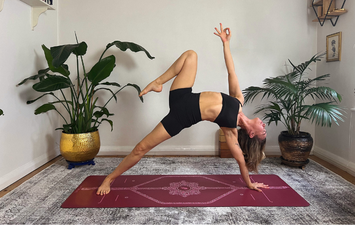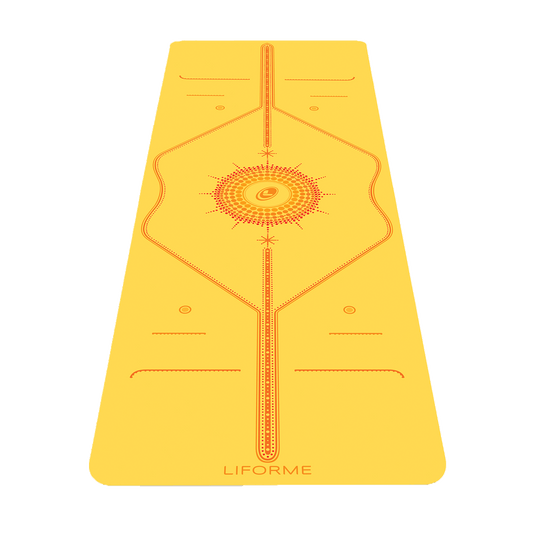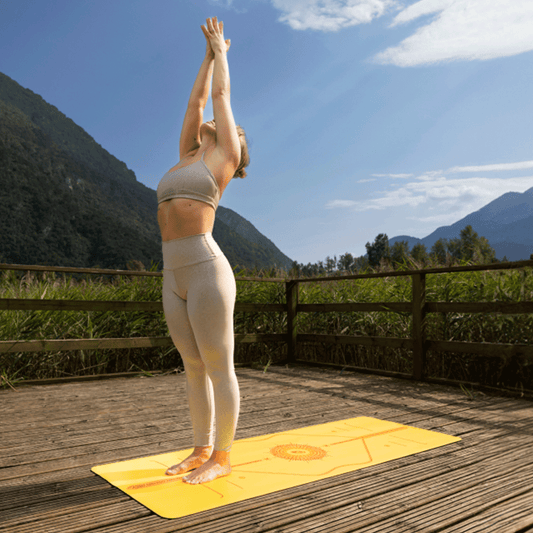Lotus is an iconic posture that is often used to represent a yogi who is fully grounded, present, and working toward inner peace. The prevalence of the lotus symbol in yoga practice and philosophy has a long history originating in the earliest surviving yoga sources Many people believe that the postural practice we know today arose from the necessity of opening the body to sit for in Lotus.
However, Lotus is not a fast pass to nirvana. Being able to do Lotus only means that you have hips that allow you to do Lotus, which, more often than not, come from the genetic lottery. If Lotus isn’t in your near future, don’t despair. There are plenty of other ways to sit for meditation more comfortably.
Lotus Pose Basics
Sanskrit Meaning: Padma (Lotus) Asana (Pose)
Yoga Level: Advanced
Pose Type: Seated
Benefits: Opens the hips. Stretches the ankles and feet.
Precautions: Avoid if you have any knee issues.
Props: A blanket, block, or bolster to sit on
Alignment Tips to Keep in Mind
Coming into a full Lotus posture requires that the heads of the femurs have a wide range of motion for external rotation in the hip sockets, which we often call having open hips. If the femurs’ range of motion is more limited, the external rotation gets passed down the legs to the knees, which is not a stable position for them and can result in injury.
We’re going to take the alignment of Lotus step by step so that the entry is as safe as possible. Along the way, we’ll pass through Half Lotus (Ardha Padmasana), which is a great place for many people to stop.
Step By Step Instructions
1. Begin by sitting on your mat with both your legs outstretched and your knees slightly soft.
2. Bend your right leg and bring your right heel as close to your right buttock as possible with the sole of the right foot flat on your mat. This protects your knee by ensuring that it is fully flexed (bent) and that all your external rotation is coming from your hip.
3. Externally rotate your right femur in the hip socket so that your right knee opens to the right.
4. Use your hands to bring your right foot to the left thigh with the sole of your foot facing upwards. To deepen, pull your right foot closer to your left hip crease and allow your right knee to lower toward the floor. 5. If you bend your left knee and tuck your left foot under your right knee, you will be in Half Lotus. If you’re going be sitting for a while, you may want to take some padding under your butt so that your hips are above your knees.
5. If you bend your left knee and tuck your left foot under your right knee, you will be in Half Lotus. If you’re going be sitting for a while, you may want to take some padding under your butt so that your hips are above your knees.
6. If you have further to go, you’re going to repeat the same process with your left leg by bending your knee and drawing your left heel in close to your left buttock and then using your hands to position your left foot on the top of your right thigh with the left sole facing upwards.
7. When you have both feet in position, activate the feet and release both your knees toward the floor as much as possible.
8. You can bring your hands to Anjali mudra at your heart, Gyan mudra on each knee, or another position of your choice.
 9. If you feel any kind of twinge or pain in either knee, come out of the pose.
9. If you feel any kind of twinge or pain in either knee, come out of the pose.
10. Traditionally, Lotus is taught with the right leg on the bottom and left leg on top. Modern practitioners often choose to spend equal time with the leg positions reversed for balance.
Other Options for Meditation
If Lotus doesn’t work for your body, don’t worry. There are lots of other options when it comes to seated poses for meditation, including Half Lotus, Easy Pose (Sukhasana), and Hero Pose (Virasana).
Lotus Variations
 Reclined Lotus (Supta Padmasana)
Reclined Lotus (Supta Padmasana)
From seated Lotus, lower to your elbows and then to your back. Keep pressing your knees and your lower back toward the mat.
 Lotus Handstand
Lotus Handstand
This advanced posture combines the challenge of balancing in handstand with the flexibility required for Lotus. To do this posture, or any Lotus inversion you must be able to come into Lotus legs without using your hands.
Mantra, Mudra, and More
In additional to Lotus Pose, yoga also includes a lotus mudra (hand gesture) and a mantra (chant repeated during meditation).
Lotus Mudra
1. Bring your hands into Anjali Mudra with the palms pressed together.
2. Keep your thumbs, pinkies, and the bottom edges of your palms touching as you open your three middle fingers on each hand outwards.
3. This creates a cupping of your two palms and forms the shape of an open lotus flower.
This mudra is said to direct prana (energy) toward your heart center.
Om Mani Padme Hum
This mantra, which translates to "the jewel is in the lotus" or "hail the jewel in the lotus," emphasizes the importance of the symbolism of the lotus in Buddhism, where it is used to represent the eight-fold path and the transcendence of the enlightened above the soiled world.
This last meaning is often the one that resonates most with modern yogis. The lotus plant grows with its roots in the muddy bottom of a body of water, while its leaves and flowers soar above the water, unmarked by their journey to the surface. Many find inspiration in the emergence of this remarkable flower from a messy place.




































